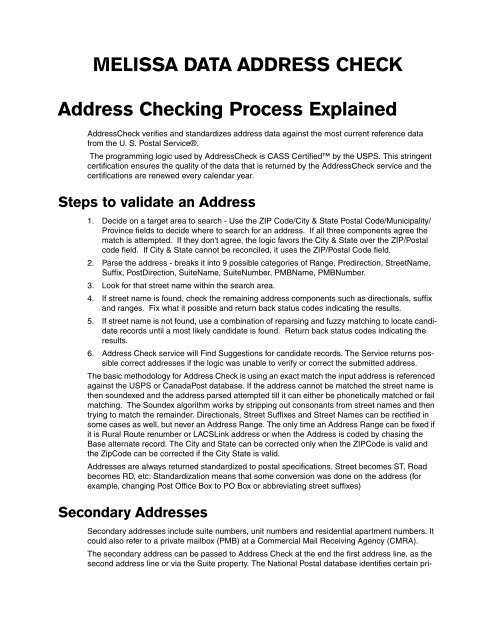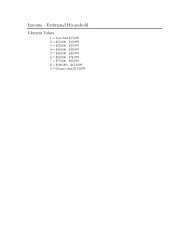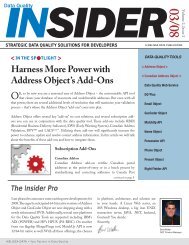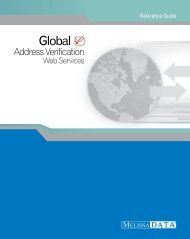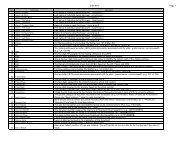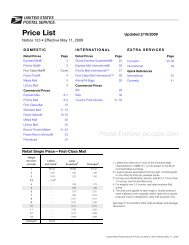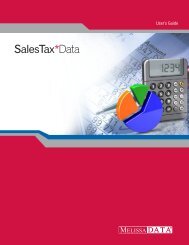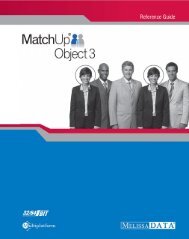Address Check - Melissa Data
Address Check - Melissa Data
Address Check - Melissa Data
Create successful ePaper yourself
Turn your PDF publications into a flip-book with our unique Google optimized e-Paper software.
MELISSA DATA ADDRESS CHECK<br />
<strong>Address</strong> <strong>Check</strong>ing Process Explained<br />
<strong>Address</strong><strong>Check</strong> verifies and standardizes address data against the most current reference data<br />
from the U. S. Postal Service®.<br />
The programming logic used by <strong>Address</strong><strong>Check</strong> is CASS Certified by the USPS. This stringent<br />
certification ensures the quality of the data that is returned by the <strong>Address</strong><strong>Check</strong> service and the<br />
certifications are renewed every calendar year.<br />
Steps to validate an <strong>Address</strong><br />
1. Decide on a target area to search - Use the ZIP Code/City & State Postal Code/Municipality/<br />
Province fields to decide where to search for an address. If all three components agree the<br />
match is attempted. If they don't agree, the logic favors the City & State over the ZIP/Postal<br />
code field. If City & State cannot be reconciled, it uses the ZIP/Postal Code field.<br />
2. Parse the address - breaks it into 9 possible categories of Range, Predirection, StreetName,<br />
Suffix, PostDirection, SuiteName, SuiteNumber, PMBName, PMBNumber.<br />
3. Look for that street name within the search area.<br />
4. If street name is found, check the remaining address components such as directionals, suffix<br />
and ranges. Fix what it possible and return back status codes indicating the results.<br />
5. If street name is not found, use a combination of reparsing and fuzzy matching to locate candidate<br />
records until a most likely candidate is found. Return back status codes indicating the<br />
results.<br />
6. <strong>Address</strong> <strong>Check</strong> service will Find Suggestions for candidate records. The Service returns possible<br />
correct addresses if the logic was unable to verify or correct the submitted address.<br />
The basic methodology for <strong>Address</strong> <strong>Check</strong> is using an exact match the input address is referenced<br />
against the USPS or CanadaPost database. If the address cannot be matched the street name is<br />
then soundexed and the address parsed attempted till it can either be phonetically matched or fail<br />
matching. The Soundex algorithm works by stripping out consonants from street names and then<br />
trying to match the remainder. Directionals, Street Suffixes and Street Names can be rectified in<br />
some cases as well, but never an <strong>Address</strong> Range. The only time an <strong>Address</strong> Range can be fixed if<br />
it is Rural Route renumber or LACSLink address or when the <strong>Address</strong> is coded by chasing the<br />
Base alternate record. The City and State can be corrected only when the ZIPCode is valid and<br />
the ZipCode can be corrected if the City State is valid.<br />
<strong>Address</strong>es are always returned standardized to postal specifications. Street becomes ST, Road<br />
becomes RD, etc: Standardization means that some conversion was done on the address (for<br />
example, changing Post Office Box to PO Box or abbreviating street suffixes)<br />
Secondary <strong>Address</strong>es<br />
Secondary addresses include suite numbers, unit numbers and residential apartment numbers. It<br />
could also refer to a private mailbox (PMB) at a Commercial Mail Receiving Agency (CMRA).<br />
The secondary address can be passed to <strong>Address</strong> <strong>Check</strong> at the end the first address line, as the<br />
second address line or via the Suite property. The National Postal database identifies certain pri-


